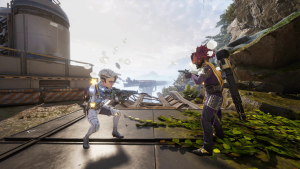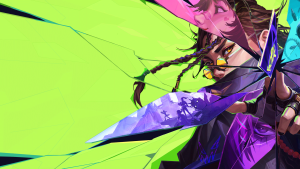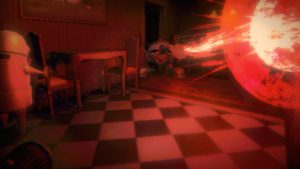Baldur’s Gate 3 – perhaps the most expansive and ambitious CRPG ever made – is now out of early access, and the absurd amount of choice and consequence on offer have driven it to the top of Steam’s bestseller charts. However, the class and combat system within the game can be overwhelming, especially for people unfamiliar with CRPGs or pen-and-paper roleplaying systems. If you’re jumping into Baldur’s Gate 3 without much knowledge of Dungeons and Dragons, this handy guide will give you an overview of each class from both a tactical and a role-playing perspective.
How Classes Work in Baldur’s Gate 3
In BG3, classes and their mechanics are directly adapted from Dungeons and Dragons 5th Edition, the latest version of the long-running tabletop game. That means that everything they do, from casting spells to talking their way out of trouble, revolves around the roll of a 20-sided dice and six main character stats (or ability scores):
⦁ Strength (STR), which measures your character’s bodily power and raw physical force. STR has a direct impact on the amount of damage you do with melee weapons.
⦁ Dexterity (DEX) measures how quick, nimble, and stealthy your character is and has an impact on the effectiveness of ranged weapons.
⦁ Constitution (CON) is a measurement of your character’s health and sturdiness, and naturally contributes to your HP pool.
⦁ Intelligence (INT) is a measurement of your character’s ability to think rationally, recall information, and make logical deductions. It’s important for some spellcasters.
⦁ Wisdom (WIS), on the other hand, measures your intuition, your connection to the natural world, and your innate perceptiveness. Wisdom is also a main spellcasting stat for some classes.
⦁ Charisma (CHA) is a measurement of how charming, confident, eloquent, or commanding you are. It opens some interesting roleplaying options and is a spellcasting stat for some classes.
Classes in BG3 are really a collection of tools and skills that take advantage of these ability scores in unique ways. After decades of refinement in DnD, each class serves a distinct and balanced role within a party, so it’s usually a safe bet to have a variety of classes at your disposal to deal with anything the game throws at you.
The level cap in BG3 is Level 12. Over the course of the game, your characters will level up 12 times, and each level will add new tools to your kit and give you options to specialise into even more unique roles.
Read More: GameStop’s CEO Has Been Fired Amidst Falling Sales
How to multi-class in BG3
When you level up in BG3, you’re always given the option to put your new level into a different class. This can be done by clicking the slightly obscure “add class” button on the level-up screen, as seen below.

Since there are no restrictions on class combinations, there is a staggering amount of flexibility on offer for curious players – with occasionally surprising results. However, if you’re looking to have the best experience on your first playthrough, you might want to stick to single-classing. Once you’re familiar with each class you’ll be able to know what their strengths and weaknesses are and where different classes will best synergise.
Each class levels up separately, so if you multi-class, you won’t reach the highest potential of any of your classes. You’ll be trading this in for flexibility and a diversity of skills. As an example, a character at the maximum level of 12 could be a level 6 Fighter and a level 6 Wizard.
There are also a couple of restrictions placed on multi-class characters:
⦁ You do not get the proficiencies of your new class. For example, Monks start with proficiency in “simple weapons”, while Fighters start with proficiency in both simple and martial weapons. If a Monk multi-classes into a Fighter, they won’t get the proficiency in martial weapons.
⦁ Your starting HP is based on your first class, so if you’ve got an idea in mind for your multi-class character, you might want to start with the class that offers the highest HP.
Each Class in Baldur’s Gate 3, Explained
Barbarian
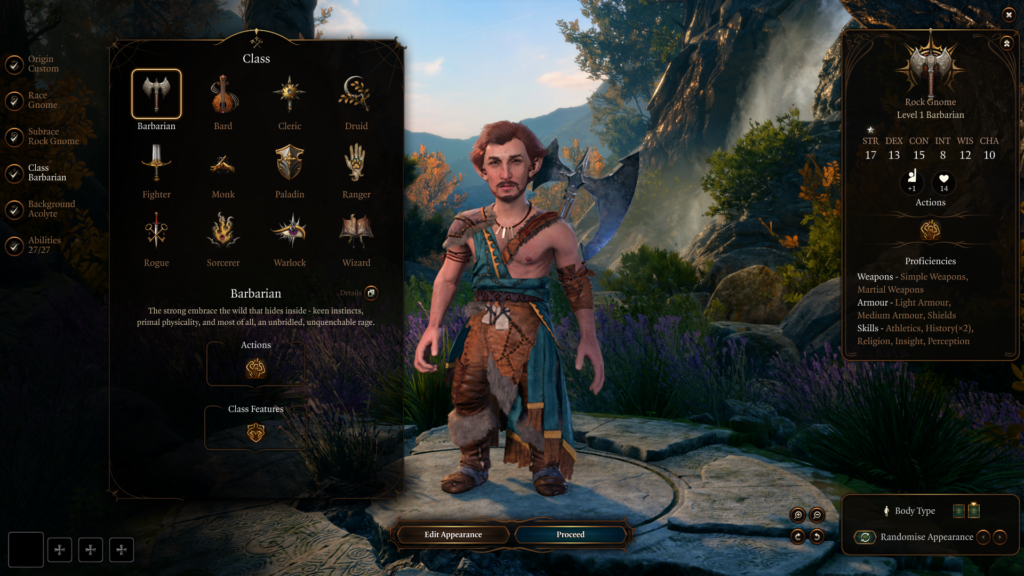
Main Ability Score: Strength
Summary: A primal warrior, relying on brute strength and rage to excel in combat. They soak up damage and deal heavy hits, often seen as fierce and untamed berserkers.
Barbarians are excellent front-line melee fighters thanks to one of their unique class abilities, Rage. You can activate Rage during combat and gain several benefits: bonus damage when you hit enemies, resistance to physical damage, and advantage on Strength checks and saving throws (i.e., any roll in combat that relies on Strength). When Raging, Barbarians cannot cast or concentrate on spells, meaning any Barbarian needs to think extra carefully about multi-classing into a spellcaster.
As Barbarians level up, they gain skills that help them move faster in combat, make more attacks on their turn, get more advantages for saving throws, and generally deal even more damage. Barbarians are truly the no-fuss melee class and can survive a remarkably long time in combat without support from other party members.
Bard
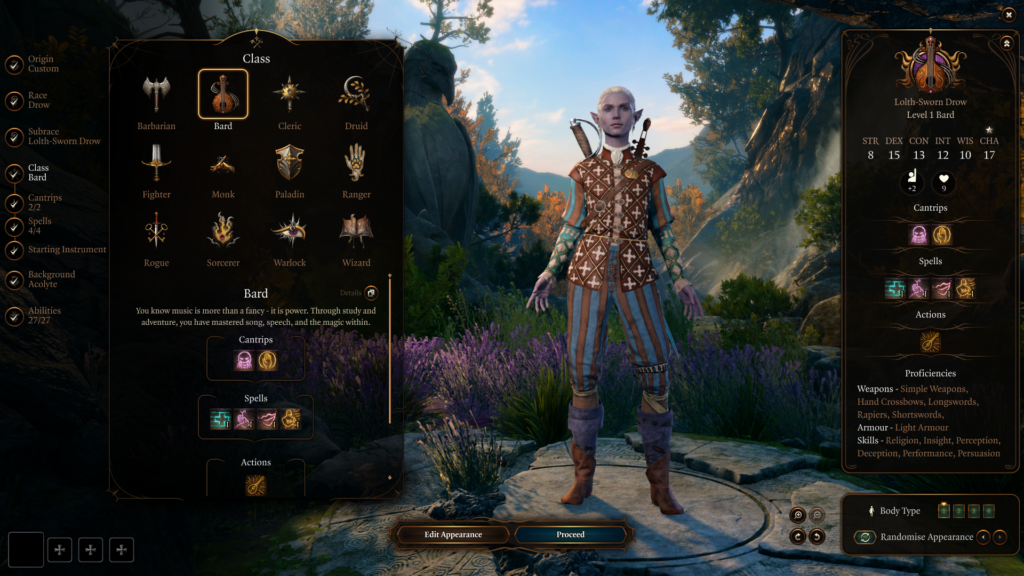
Main Ability Score: Charisma
Summary: A versatile performer and spellcaster, using music, poetry, oration, and charm to inspire allies, manipulate enemies, and cast spells. They provide support and utility on the battlefield.
Bards are a great support class thanks to their jack-of-all-trades skillset. Their primary class feature is a buff-granting mechanic called Bardic Inspiration, which grants allies a bonus to rolls during combat by spending a class-specific resource. They also gain access to a wide range of spells from multiple spellcasting schools, making them adaptable in any situation – even frontline combat, with the right specialisation.
As Bards level up, they acquire additional features that enhance their musical abilities, such as Countercharm to protect against certain magical effects, or Magical Secrets, allowing them to learn spells from any class’s spell list.
Cleric

Main Ability Score: Wisdom
Summary: A devout divine spellcaster, serving a deity or higher power. They heal, protect, and buff allies while smiting foes with holy powers.
When you create a Cleric, you’ll be asked to choose their Domain which will determine the shape of your abilities and focus during combat. Their core class feature, Channel Divinity, gives them access to unique skills depending on their chosen domain. Domains for Clerics include Life, which focuses on healing and restoration; Knowledge, which gives Clerics access to Wizard-esque spells and abilities; and Tempest, which focuses on dealing massive damage with destructive spells.
Clerics choose their domain at Level 1, but all Clerics gain certain abilities as they level up – specifically, Turn Undead and Destroy Undead, abilities that make them a no-brainer addition if you’re venturing into an area that’s overrun with undead enemies.
As Clerics level up, they gain access to a wide array of spells, covering healing, offensive, and supportive magic. Their spellcasting ability is fuelled by their faith, making them potent spellcasters in any party.
Druid
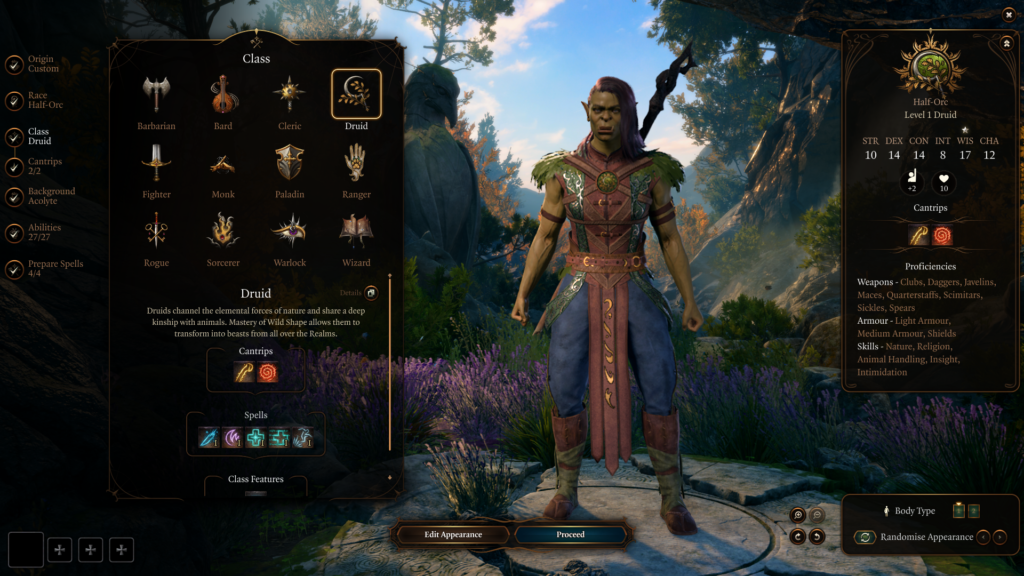
Main Ability Score: Wisdom
Summary: A nature-based spellcaster and shapeshifter, connected to the natural world. They wield elemental magic, transform into animals, and preserve the balance of nature.
The most unique aspect of the Druid class is its primary class feature: Wild Shape. This allows the Druid to transform into a variety of animals that assist in both combat and exploration. This makes them important for exploring the world in different ways, as some animals – like the Raven – can fly and reach places you wouldn’t be able to otherwise.
As Druids level up, they gain access to a wide variety of spells from the druid spell list, which emphasises elemental magic and nature-based effects. They can heal allies, control the elements, summon creatures, and inflict damage upon foes.
Fighter
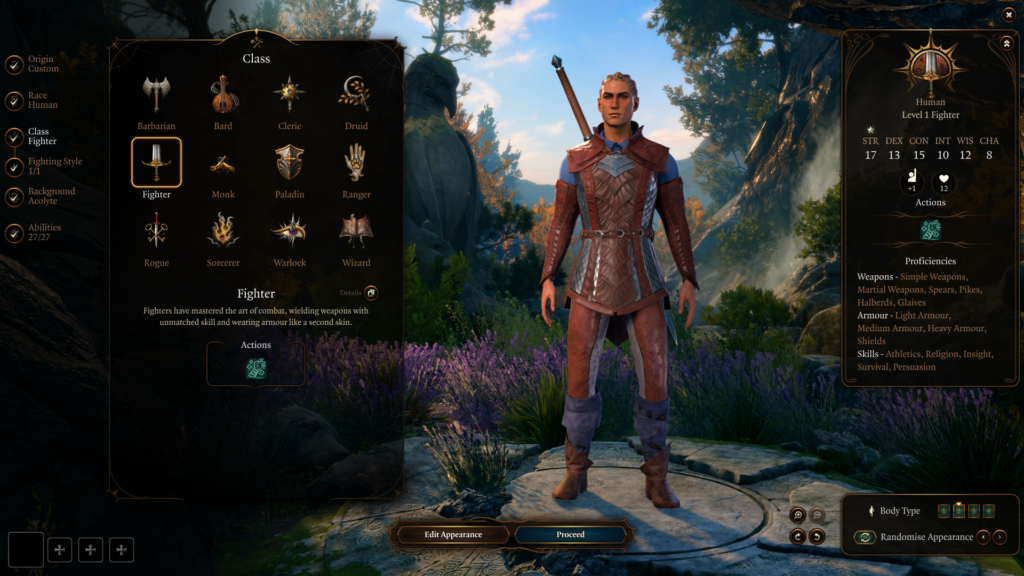
Main Ability Score: Strength
Summary: A skilled combatant mastering various weapons and armour. They excel in martial prowess and tactics, becoming experts in archery, duelling, or battlefield control.
Although they have an unassuming name, Fighters are some of the best front-line combatants in BG3, offering not only superb damage-dealing abilities but also strong defensive passives and powerful party-buffing techniques. Skills like Second Wind allow Fighters to heal themselves, while Action Surge allows them to take additional actions during combat, meaning they are some of the most self-sufficient and powerful party members.
At Level 3, Fighters choose a Martial archetype which determines their role within the party. The Battle Master uses tactical manoeuvres to control the battlefield and inspire allies, while the Champion excels in basic combat techniques. Eldritch Knight allows a Fighter to naturally spec into spellcasting, too. Overall, Fighters are a must-have for some of BG3’s most difficult and complex combat encounters.
Monk
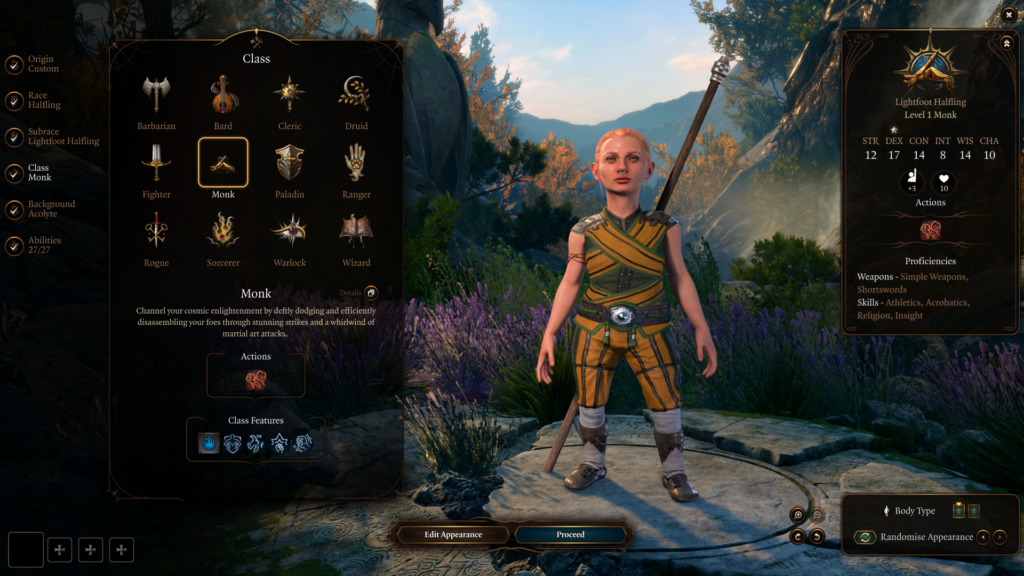
Main Ability Score: Dexterity
Summary: A disciplined martial artist, relying on speed, agility, and ki energy. They specialise in unarmed strikes and unique combat abilities, while being highly mobile and agile.
Monks are a high-risk, high-reward melee class that can be incredibly satisfying to master. One of their core abilities, Flurry of Blows, allows them to make extra unarmed attacks during their turn, while Deflect Missiles opens the opportunity to catch arrows in mid-air and throw them back at enemies. Since Monks specialise in unarmoured combat, managing their HP and defences is a crucial part of keeping them dangerous.
At level 3, Monks choose a Monastic Tradition: The Way of the Open Hand lets them lean into their powerful melee capabilities, the Way of the Four Elements gives them elemental spellcasting utility, and the Way of Shadow turns them into stealthy ninjas for some Rogue-like charm.
Paladin

Main Ability Score: Strength
Summary: A holy warrior, sworn to an oath that grants divine powers. They combine martial skills with divine spellcasting, emphasising righteousness and smiting evil.
Paladins offer a lot of fun for avid role-players as they choose an Oath at Level 1 which determines what actions they consider right and proper, based on their traditions. If you go against these actions during the game, you risk breaking your oath, restricting you in some ways but in others offering the ability to play as a fallen Paladin who has gone against their oath.
Paladins gain several offensive and defensive abilities like Divine Smite to deal extra damage, Lay on Hands for light healing, and Auras for improved saving throws or protection against debuffs. Paladins are another excellent choice for front-line combat and use divine magic (scaling from their Charisma score) to embody the ideals of their oath.
Ranger
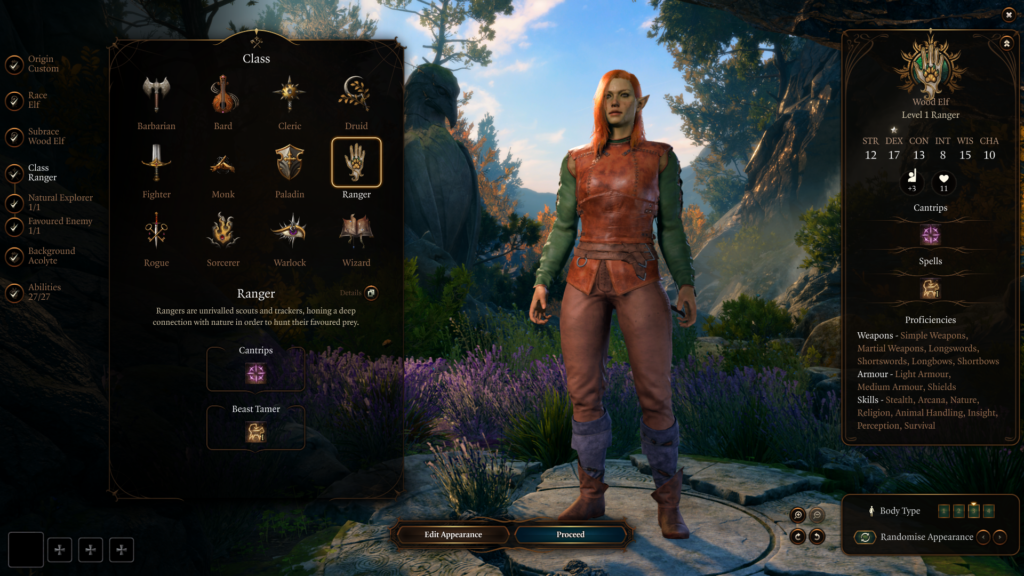
Main Ability Score: Dexterity
Summary: A skilled tracker and wilderness expert, attuned to nature. They excel in ranged combat and scouting, often forming bonds with animals and utilising nature-based spells.
Although Rangers excel in ranged combat, they are incredibly flexible, allowing you to specialise in melee combat or spellcasting depending on your preferences. One of their key features is the Favoured Enemy ability, which grants them advantages when dealing with specific types of creatures, such as beasts or undead.
Furthermore, Rangers can forge a strong bond with a Beast Companion, gaining an animal ally that aids them in battle and exploration. As they progress, they acquire powerful spells that complement their combat abilities and enhance their tracking and survival skills. They become adept at ambushing foes, gaining situational advantages, and dealing significant damage in surprise attacks. Rangers can provide valuable utility to the party, such as detecting and neutralising threats, and they are especially valuable in outdoor and wilderness settings.
Rogue

Main Ability Score: Dexterity
Summary: A cunning and stealthy expert in subterfuge. They specialise in sneaking, picking locks, and dealing sneak attacks, making them great scouts and skilful thieves.
Another versatile class than can specialise in all three kinds of combat is the Rogue, although their out-of-combat utility is just as – if not more – important. Rogues excel in stealth, lockpicking and disarming traps, which means they are a necessity for some dungeons and areas that would otherwise be inaccessible.
Rogue subclasses specialise the character into either a master of stealth and subterfuge through the Thief specialisation, an ultimate single-target damage dealer through the Assassin, or a spellcaster thanks to the Arcane Trickster. Rogues can pull off some remarkable combat feats with their naturally high Critical Hit chance, but also tend to have low HP pools, meaning you’ll need to take advantage of stealth whenever possible.
Sorcerer
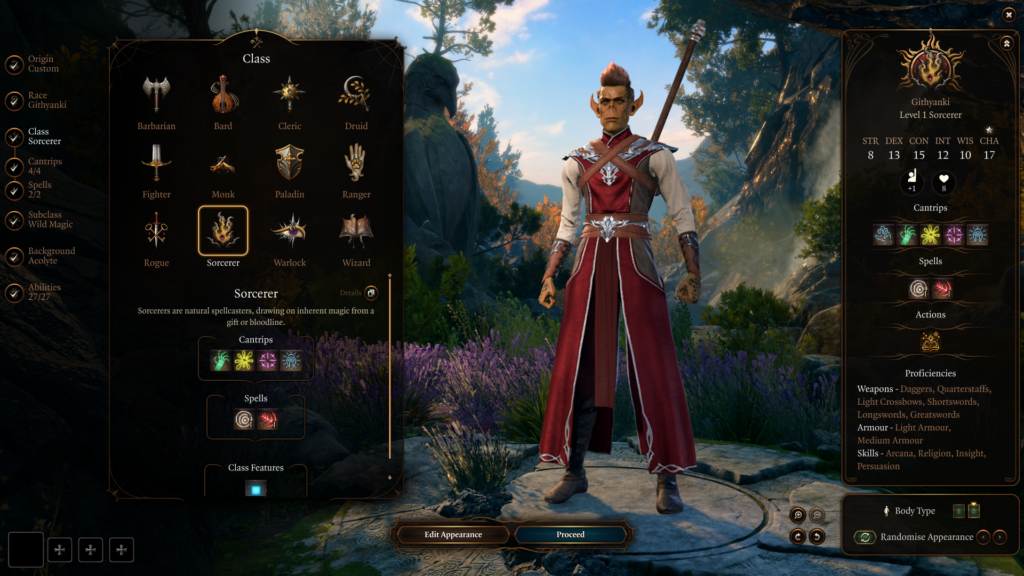
Main Ability Score: Charisma
Summary: A spellcaster with innate magical abilities. Their magic stems from bloodlines or other sources, allowing them to cast powerful spells with raw arcane energy.
Unlike wizards, who study and memorise spells, sorcerers possess an innate gift that allows them to cast spells spontaneously. In BG3, their gift takes the form of the Sorcerer’s subclass which can be picked at Level 1. A Draconic sorcerer gains the benefits of a powerful dragon ancestor, making them sturdier and more resilient in combat – perfect for a melee/spellcaster hybrid. Storm Sorcerers gain the unique ability to fly after casting spells during combat, making them incredibly mobile. Meanwhile, Wild Magic Sorcerers bring a chaotic edge to any encounter by spawning random magical effects that can make or break most fights.
Sorcerers rely on their Charisma attribute to determine the effectiveness of their spells, making them charming and persuasive individuals outside of combat. However, their reliance on Charisma also means they need to carefully manage their spell selection and the number of spells they can cast in a day.
Warlock
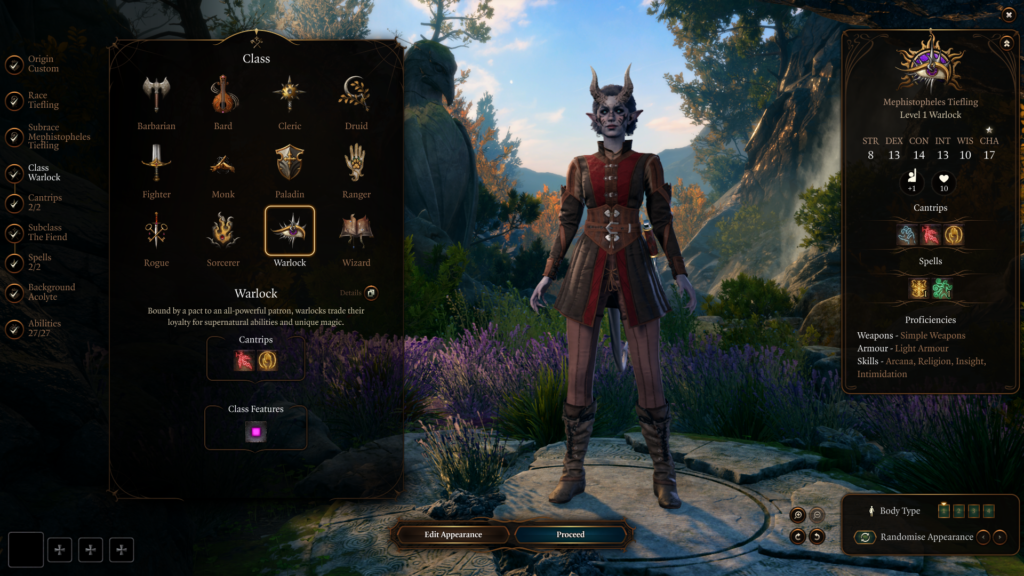
Main Ability Score: Charisma
Summary: A spellcaster who forms a pact with a powerful entity. They gain eldritch abilities and invocations, receiving magical powers from their patron in exchange for service.
Unlike other spellcasters, Warlocks have a limited number of spell slots, but they regain their slots after a short rest, allowing them to consistently cast spells throughout the day. This makes them powerful in short bursts but resource-intensive overall, as you can only take two short rests before being forced to take a long rest, which costs camp supplies.
Warlocks make up for this through their powerful bond with otherworldly entities. In BG3, Warlocks choose their bond at Level 1: a bond with The Fiend gains temporary HP after killing enemies, enhancing their survivability, while a bond with The Great Old One can passively frighten enemies after critically hitting them. A bond with The Archfey gives even more debuffing utility through Charm and Frighten effects. Overall, Warlocks burn the candle at both ends, making them devastating for short periods of time but expensive to keep their momentum up.
Wizard
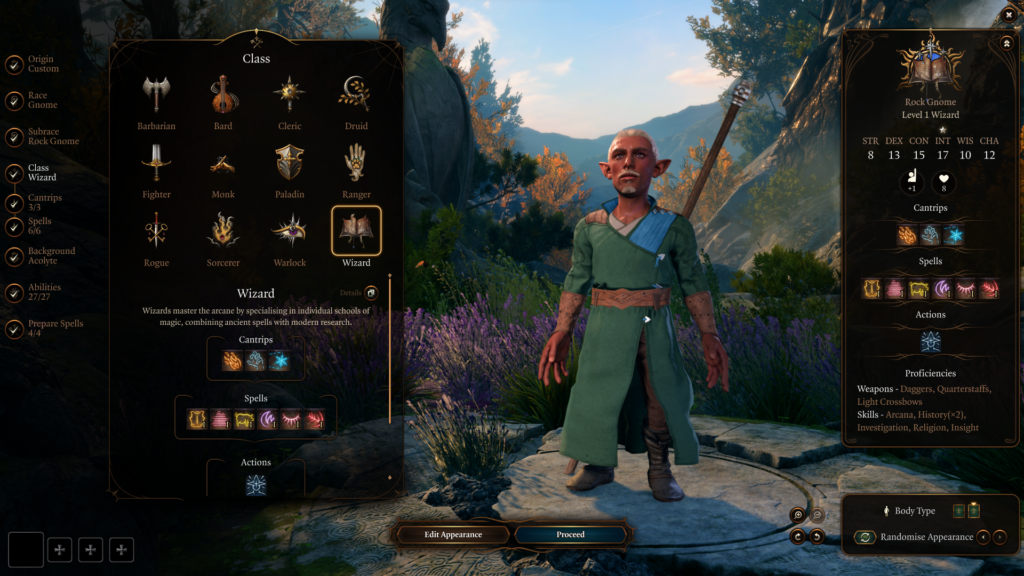
Main Ability Score: Intelligence
Summary: A scholarly spellcaster mastering arcane magic through study and spellbooks. They possess a vast array of spells, making them versatile and capable of controlling the battlefield through various magical effects.
Finally, the Wizard class represents the learned scholar of magic who uses their intelligence to rigorously study and practice the arcane arts. Wizards can learn and keep spells in their spellbook and then prepare a certain number of spells out-of-combat, meaning they can harness an incredibly versatile skillset that rewards preparation and forethought.
Wizards chose a subclass at Level 2 and can specialise in one of eight schools of magic. For example, Evocation magic focuses on creating elemental effects that deal damage over a large area, while Necromancy magic deals damage over time and corrupts enemies with necrotic damage. The main benefit of this specialisation is that it makes spells of this school cheaper and easier to learn, so choosing a subclass doesn’t necessarily mean that Wizards lose their incredible range or utility.
For more from Insider Gaming, check out the Modern Warfare 3 official teaser reveal.





